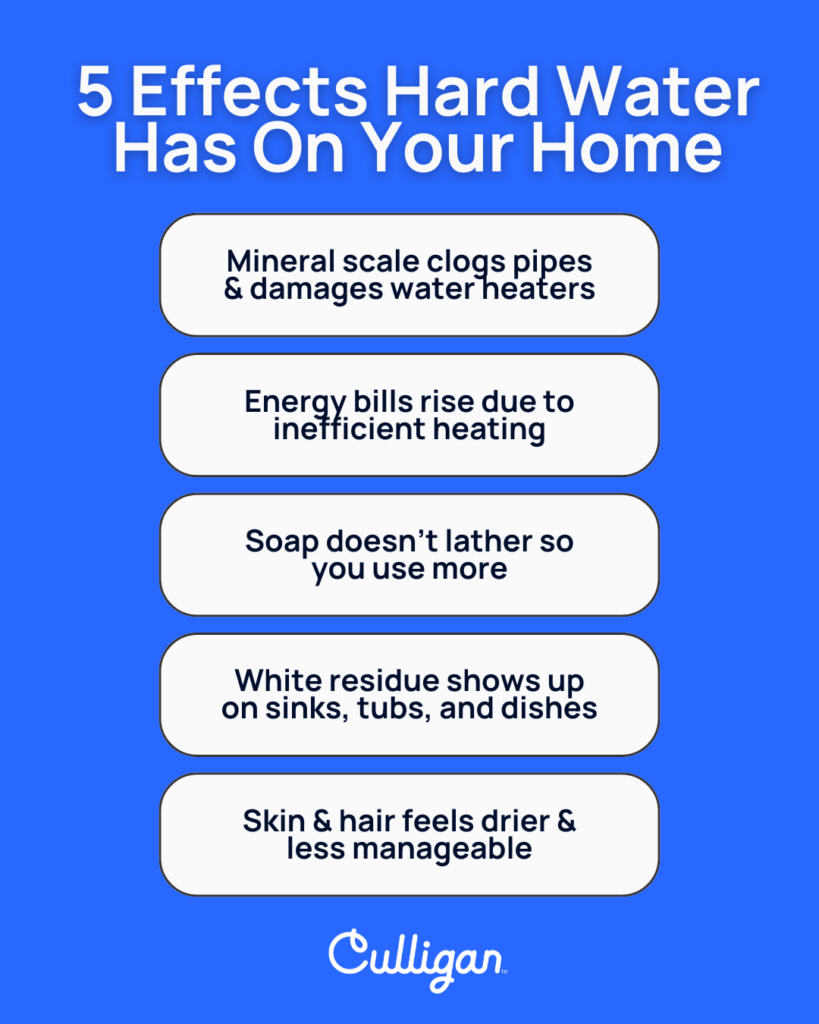Ontario Water Mineral Content: What’s In Your Tap?
Quick Summary: Ontario’s water in some areas is just below being considered hard. This mineral-heavy groundwater leads to scale, clogged fixtures, and worn-down appliances. A free home water test can guide you toward the right solution, such as a water softener or filtration system tailored to Ontario’s conditions.
Ontario residents often encounter issues like white spots on dishes, dry skin after showers, and scale buildup on faucets. These are common signs of mineral-heavy water, prevalent throughout the region.
The primary culprits are elevated levels of calcium and magnesium in the city’s water supply. While these minerals aren’t harmful to health, they can affect plumbing, appliances, and daily comfort.
Let’s explore what’s in Ontario’s water, the sources of these minerals, and how homeowners are addressing the associated challenges.
Is Ontario’s Water Hard or Soft?
Ontario’s water is classified as hard to very hard, based on data from the City of Ontario’s 2023 Water Quality Report and the Environmental Working Group (EWG).
Key findings from the 2023 report include:
- Total Hardness (as CaCO₃): Approximately 123 mg/L, or 7.2 grains per gallon.
- Calcium levels: Averaging around 22-46 mg/L.
- Magnesium levels: Approximately 3.7-9.8 mg/L.
- Total Dissolved Solids (TDS): Ranging between 180-230 mg/L in some zones.
According to the U.S. Geological Survey, water with over 180 mg/L of hardness is considered “very hard,” placing Ontario’s water under the hard category.
While hard water is safe to drink, it can lead to several household inconveniences.
Sources of Ontario’s Water Minerals
1. Water Origins
Ontario’s water is sourced from:
- Colorado River
- State Water Project (Sacramento–San Joaquin Delta)
- Local reservoirs and groundwater basins
Both the Colorado River and the Delta are known for high mineral content, especially calcium and magnesium. As water travels through mineral-rich terrains, it accumulates these elements, resulting in hard water by the time it reaches your home.
In periods of drought, reliance on groundwater increases, which can have even higher levels of Total Dissolved Solids (TDS) and hardness, depending on the basin.
2. Infrastructure and Distribution
The city’s extensive and aging water infrastructure can contribute to trace metals like iron, copper, or zinc, especially in older neighborhoods. While these may not always appear in test results, they can influence the taste, color, and residue of tap water.
Impact of Minerals on Your Home
Though not toxic, hard water minerals can have several adverse effects on your household:
Scale Buildup on Fixtures
Calcium and magnesium can form a hard white crust (scale) on showerheads, faucets, and tiles. Over time, this buildup can clog aerators, reduce water pressure, and damage plumbing.
Appliance Efficiency and Longevity
Appliances like water heaters, dishwashers, coffee makers, and washing machines are susceptible to mineral buildup. Limescale can decrease efficiency, shorten appliance lifespan, and necessitate more frequent repairs.
Studies indicate that homes with hard water can experience a 30–50% reduction in appliance lifespan compared to those with soft water.
Increased Energy Costs
Scale inside water heaters acts as insulation, requiring more energy to heat water. This inefficiency can lead to higher energy bills over time.
Soap Scum and Skin Irritation
Hard water doesn’t lather well with soap, leading to:
- Increased soap and shampoo usage.
- Soap residue on skin, laundry, and glassware.
- Dry or itchy skin after bathing.

EWG Insights on Ontario Tap Water
The Environmental Working Group has identified several contaminants in Ontario’s water that exceed their recommended health guidelines, including:
- Chromium-6
- Nitrates
- Disinfection byproducts like HAA5 and TTHMs
While these contaminants aren’t directly related to water hardness, they contribute to overall water quality concerns, prompting many homeowners to seek improved filtration or softening solutions.
Testing Your Home’s Water
Water hardness can vary across neighborhoods and even between homes, influenced by factors like:
- Plumbing materials
- Proximity to main water lines
- Recent system repairs or upgrades
While the city’s water quality reports provide general data, a home water test offers the most accurate assessment of your tap water. These results can guide decisions on whether to install a water softener, reverse osmosis system, or whole-house filtration.
Addressing Hard Water in Ontario
Solutions Offered by Culligan Water
Culligan of Ontario has been assisting local homeowners in managing hard water issues for decades. Their systems are tailored based on individual home water test results, utilizing advanced filtration or ion exchange to reduce hardness.
Water Softener Systems
Culligan’s softeners remove calcium and magnesium through a salt-based exchange system, protecting pipes, extending appliance life, and enhancing bathing experiences.
Benefits include:
- Reduced scale buildup
- Improved skin and hair condition
- Cleaner laundry
- Fewer plumbing problems
Comprehensive Filtration Options
Many residents opt for whole-home filtration or under-sink reverse osmosis systems to eliminate chlorine, disinfection byproducts, and unpleasant tastes from tap water. These systems are particularly beneficial for those concerned about contaminants identified by the EWG.
Final Takeaway
Ontario’s water is notably hard, with high levels of calcium and magnesium affecting plumbing, comfort, and appliance longevity. Given the elevated TDS levels and regional variations, many homeowners are turning to water softeners and filtration systems to safeguard their homes and families.
The first step is a comprehensive water test. This assessment will inform the best solution tailored to your specific needs.
Curious about your home’s water hardness level? Schedule a free water test today.
